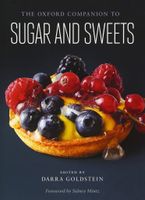Advertisement
Sweets and Popular Culture
Published 2015
The introduction of a coin valued at 4 coppers in the late 1700s prompted vendors to switch from selling five dumplings on a stick to just four; some 200 years later, many changed to three dumplings in response to the popularity of the 1999 children’s song “Three Dumpling Siblings” (dango sankyōdai). Two decades earlier, the kids’ tune “Swim Mr. Grilled Sea Bream!” (oyoge taiyakikun), which describes how a small sea bream–shaped confection escapes to the ocean, had boosted that sweet’s sales. Other sweets also have animated mascots. The hero Bean-paste Bread Man (Anpanman) debuted in 1973, showing what happens when a bun stuffed with sweetened azuki paste comes to life. Anpanman joins with other personifications of Western-style confections, including Meronpanna (Melon Bread, meron pan), to defeat the plans of Germ Man (baikinman) and his henchmen. Anpanman’s cherubic persona appears on a variety of consumer goods, and there is a museum dedicated to him in Kōchi prefecture, where local trains display his face and play his theme song. Also heavily marketed is the chubby blue cat Doraemon, who first appeared in comic books in 1969 and subsequently became a television cartoon regular. Doraemon’s namesake and favorite food is the Gong Cake (dorayaki), two pancakes sandwiching sweet azuki paste.


